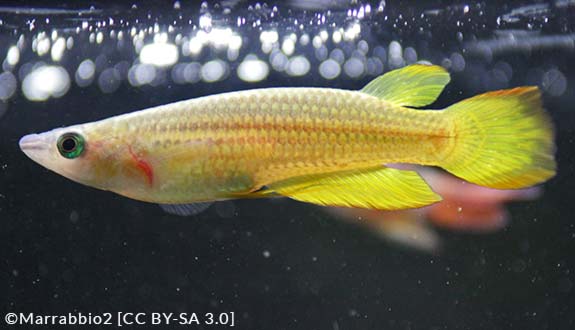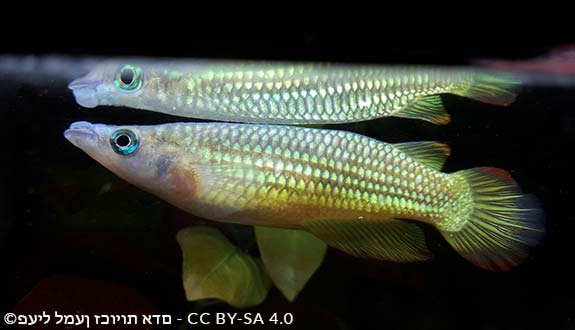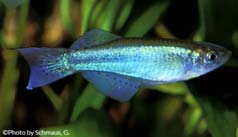

Alternative species (click on the thumbnail to see the card)
Names
Scientific name
Aplocheilus lineatus
Lineatus aplocheilus
Aplocheilus affinis
Aplocheilus vittatus
Haplochilus lineatus
Common name
Striped panchax
Golden wonder killifish
Origin

Origin: Asia, India, Sri-lanka
Biotope: Asian
Dimorphism

The male is larger and more colorful than the female.
Group

Aplocheilidae
Volume

120 L / 26 imp gal / 32 US gal
Parameters

T°: 21 à 26°C or 70 to 79°F
pH: 6 to 7.8
Hardness: 6 to 20°dGH
Difficulty

Easy
Size

8 to 10cm (3 to 4")
Longevity

5 to 6 years
Living zone

Top
Individuals

10
Food
How to feed the Aplocheilus lineatus?
Food
How to feed the Aplocheilus lineatus?
The striped Panchax is carnivorous and insectivorous. It particularly likes live prey that it hunts near the surface: live flies or small insects. This type of food is preferable because it stimulates the hunting instinct of your fish: don't deprive it of it!
To supplement, distribute tubifex, daphnia or artemia in fresh or frozen form. Finally, this fish also easily accepts traditional flakes or granules.
Behavior
What kind of behavior does the Aplocheilus lineatus have?
Behavior
What kind of behavior does the Aplocheilus lineatus have?
Panchax grows in the upper part of the aquarium, just below the water surface. It seems to be "hiding" near the plants in this area in search of prey that may be passing by. Cryptocorynes or Vallisnerias are particularly appreciated for this activity.
This gregarious species must live in groups of at least 10 individuals. In terms of infraspecific agreement, it is very good provided that there are 2 to 3 females for each male.
Generally speaking, it is very peaceful with other species, even shy. He is calm and not very active, sometimes waiting for long periods of time immobile.
He is an excellent hunter: observe him at live food distribution. Its skill and speed will surprise you! He is usually so calm... He is also patient: he is able to stay still and act very quickly to catch his prey.
Little vigilance: like many insectivorous fish, the Panchax is an excellent jumper!
Cohabitation
Who can live with the Aplocheilus lineatus?
Cohabitation
Who can live with the Aplocheilus lineatus?
Like all shy fish, it makes more sense to keep them in a specific aquarium.
Overall, cohabitation with other species goes relatively well. It ignores all the fish living at the bottom of the aquarium. Do not introduce any other species living in his living area than him, which could stress him. Note that it can become aggressive with small fish (less than 3 cm or 1").
Breeding
How to breed the Aplocheilus lineatus?
Breeding
How to breed the Aplocheilus lineatus?
For successful reproduction of the Panchax, plan a 50 litre (11 imp Gal ou 13 US Gal) container with a few floating plants and/or a root. The water will be the same as in the main aquarium, and the temperature will be 24°C (75°F).
Introduce the selected couple. After a courtship of the male, egg laying takes place. About ten eggs are stuck on the leaves of the floating plants or on the root. After laying, remove the parents, retrieve the eggs and leave them to incubate in a container of 1 cm (0.4") of water for about 12 to 15 days.
Feeding the fry: artemia nauplia.
Its aquarium
Which aquarium for the Aplocheilus lineatus?
Its aquarium
Which aquarium for the Aplocheilus lineatus?
In its natural environment, Aplocheilus lineatus generally lives in moderate current waters containing tall plants in which it hides to hunt.
In captivity, also offer a light current with filtration of 2 to 3 times the volume of the tank per hour. Orient the filter's discharge rod horizontally, just below the surface. The Panchax will position itself in front of this current to hunt!
Plant many feet of Cryptocoryne or Vallisneria, as well as floating plants.
The striped Panchax is able to quickly adapt to the conditions of your aquarium thanks to the diversity of the natural environments in which it is found: streams, brooks, rivers, swamps...
Good To know
Find all additional information!
Good To know
Find all additional information!
The basic colours of this fish are blue and red. However, there is also a yellow variant (called "Gold").
Aplocheilus lineatus Gold

Yours photos!
Comments
Sort by:
Please login to post comments


